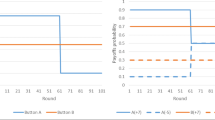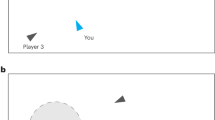Abstract
Joint cognition refers to the mental systems that support group performance when carrying out a shared, or jointly owned task. We focused here on understanding the social configurations that underpin key phenomena in joint cognition, in particular, whether individual cognition in task-sharing environments is mostly shaped by social factors or not. To this end, we investigated, first and mainly, whether human presence is necessary for the creation of joint performance; second and separately, whether prior experience of task sharing has an adaptive influence on subsequent individual choices; and third and additionally, whether individual differences in a social trait mediate joint performance. We describe an experiment in which participants combined with another human or a computer as they attempted to generate a paired sequence that was as random as possible. First, we found little difference in joint performance with regard to whether a human or a computer was the co-participant, except for immediate repetitive response. Second, we found evidence for choice adaptation, but only under the lower time pressure. Third, we replicated previous research in which no systematic link was established between social desirability and joint performance. We conclude that joint cognition phenomena may be rooted primarily in turn-taking configurations rather than in social dynamics per se.



Similar content being viewed by others
Notes
A two-way mixed ANOVA for individual immediate repetition with task order (before and after joint conditions; between-participants) and response pace (slow and fast; within-participants) as factors indicated that an interaction between the two factors was not significant, F(1, 36) = 0.07, p = 0.787, η2 = 0.002. We suggest this is because variance of immediate repetition is commonly too large. However, we suggested the necessity of closer inspection of choice adaptation and then set up a specific hypothesis that slow response pace, but not fast response pace, in individual task helped participants intentionally apply repetitive responses that they had experienced in joint task. Therefore, we administered separate analyses for the slow and fast response pace.
Mann–Whitney’s U test: U = 124.0, z = 1.81, p = 0.070.
Mann–Whitney’s U test: U = 143.5, z = 1.09, p = 0.278.
We thank a reviewer for identifying this possibility.
Mann–Whitney’s U test: U = 142.5, z = 1.08, p = 0.280.
Mann–Whitney’s U test: U = 158.5, z = 0.68, p = 0.495.
Mann–Whitney’s U test: U = 138.5, z = 1.24, p = 0.215.
Mann–Whitney’s U test: U = 159.5, z = 0.65, p = 0.516.
References
Allport, A., Styles, E. A., & Hsieh, S. (1994). Shifting intentional set: Exploring the dynamic control of tasks. In C. Umilta & M. Moscovitch (Eds.), Attention and performance (Vol. XV, pp. 421–452). Cambridge: MIT Press.
Baddeley, A. D. (1966). The capacity for generating information by randomization. Quarterly Journal of Experimental Psychology, 18(2), 119–129.
Baron-Cohen, S., Wheelwright, S., Skinner, R., Martin, J., & Clubley, E. (2001). The autism-spectrum quotient (AQ): Evidence from Asperger syndrome/high-functioning autism, males and females, scientists and mathematicians. Journal of Autism and Developmental Disorders, 31(1), 5–17.
Brugger, P. (1997). Variables that influence the generation of random sequences: An update. Perceptual and Motor Skills, 84(2), 627–661.
Cooper, R. P. (2016). Executive functions and the generation of “random” sequential responses: A computational account. Journal of Mathematical Psychology, 73(1), 153–168.
Crowne, D. P., & Marlowe, D. (1960). A new scale of social desirability independent of psychopathology. Journal of Consulting Psychology, 24(4), 349–354.
Davis, M. H. (1983). Measuring individual differences in empathy: Evidence for a multidimensional approach. Journal of Personality and Social Psychology, 44(1), 113–126.
Dolk, T., Hommel, B., Colzato, L. S., Schutz-Bosbach, S., Prinz, W., & Liepelt, R. (2014a). The joint Simon effect: A review and theoretical integration. Frontiers in Psychology, 5, 974.
Dolk, T., Hommel, B., Prinz, W., & Liepelt, R. (2014b). The joint flanker effect: Less social than previously thought. Psychonomic Bulletin and Review, 21(5), 1224–1230.
Dudarev, V., & Hassin, R. R. (2016). Social task switching: On the automatic social engagement of executive functions. Cognition, 146, 223–228.
Evans, F. J. (1978). Monitoring attention deployment by random number generation: An index to measure subjective randomness. Bulletin of the Psychonomic Society, 12(1), 35–38.
Hoppitt, W., & Laland, K. N. (2013). Social learning: An introduction to mechanism, methods, and models. Princeton: Princeton University Press.
Jahanshahi, M., Dirnberger, G., Fuller, R., & Frith, C. D. (2000). The role of dorsolateral prefrontal cortex in random number generation: A study with positron emission tomography. Neuroimage, 12(6), 713–725.
Jersild, A. T. (1927). Mental set and shift (p. 89). No: Archives of Psychology.
Kiesel, A., Steinhauser, M., Wendt, M., Falkenstein, M., Jost, K., Philipp, A. M., & Koch, I. (2010). Control and interference in task switching—a review. Psychological Bulletin, 136(5), 849–874.
Knoblich, G., Butterfill, S., & Sebanz, N. (2011). Psychological research on joint action: Theory and data. In B. Ross (Ed.), The psychology of learning and motivation (Vol. 54, pp. 59–101). Burlington: Academic Press.
Krach, S., Hegel, F., Wrede, B., Sagerer, G., Binkofski, F., & Kircher, T. (2008). Can machines think? Interaction and perspective taking with robots investigated via fMRI. PLoS One, 3(7), e2597.
Liefooghe, B. (2016). Joint task switching. Journal of Cognitive Psychology, 28(1), 60–78.
Mattick, R. P., & Clarke, J. C. (1998). Development and validation of measures of social phobia scrutiny fear and social interaction anxiety. Behaviour Research and Therapy, 36(4), 455–470.
Miyake, A., Friedman, N. P., Emerson, M. J., Witzki, A. H., Howerter, A., & Wager, T. D. (2000). The unity and diversity of executive functions and their contributions to complex “frontal lobe” tasks: A latent variable analysis. Cognitive Psychology, 41(1), 49–100.
Müller, B. C. N., Kühn, S., van Baaren, R. B., Dotsch, R., Brass, M., & Dijksterhuis, A. (2011). Perspective taking eliminates differences in co-representation of out-group members’ actions. Experimental Brain Research, 211(3–4), 423–428.
Neuringer, A. (1986). Can people behave “randomly”?: The role of feedback. Journal of Experimental Psychology: General, 115(1), 62–75.
Nijstad, B. A., & Stroebe, W. (2006). How the group affects the mind: A cognitive model of idea generation in groups. Personality and Social Psychology Review, 10(3), 186–213.
Obhi, S. S., & Hall, P. (2011). Sense of agency and intentional binding in joint action. Experimental Brain Research, 211(3–4), 655–662.
Oyserman, D., Coon, H. M., & Kemmelmeier, M. (2002). Rethinking individualism and collectivism: Evaluation of theoretical assumptions and meta-analyses. Psychological Bulletin, 128(1), 3–72.
Press, C. (2011). Action observation and robotic agents: Learning and anthropomorphism. Neuroscience and Behavioral Reviews, 35, 1410–1418.
Rogers, R. D., & Monsell, S. (1995). Costs of a predictable switch between simple cognitive tasks. Journal of Experimental Psychology: General, 124(2), 207–231.
Sebanz, N., Bekkering, H., & Knoblich, G. (2006). Joint action: Bodies and minds moving together. Trends in Cognitive Sciences, 10(2), 70–76.
Simmons, J. P., Nelson, L. D., & Simonsohn, U. (2012). A 21 word solution. https://ssrn.com/abstract=2160588. Accessed 15 May 2017.
Stenzel, A., Chinellato, E., Tirado Bou, M. A., del Pobil, Á. P., Lappe, M., & Liepelt, R. (2012). When humanoid robots become human-like interaction partners: Co-representation of robotic actions. Journal of Experimental Psychology: Human Perception and Performance, 38(5), 1073–1077.
Towse, J. N. (1998). On random generation and the central executive of working memory. British Journal of Psychology, 89(1), 77–101.
Towse, J. N., & Mclachlan, A. (1999). An exploration of random generation among children. British Journal of Developmental Psychology, 17(3), 363–380.
Towse, J. N., & Neil, D. (1998). Analyzing human random generation behavior: A review of methods used and a computer program for describing performance. Behavior Research Methods, Instruments and Computers, 30(4), 583–591.
Towse, J. N., Towse, A. S., Saito, S., Maehara, Y., & Miyake, A. (2016). Joint cognition: Thought contagion and the consequences of cooperation when sharing the task of random sequence generation. PLoS One, 11(3), e0151306.
Vesper, C., Abramova, E., Bütepage, J., Ciardo, F., Crossey, B., Effenberg, A., & Wahn, B. (2017). Joint action: Mental representations, shared information and general mechanisms for coordinating with others. Frontiers in Psychology, 7, 2039.
Wenke, D., Atmaca, S., Holländer, A., Liepelt, R., Baess, P., & Prinz, W. (2011). What is shared in joint action? Issues of co-representation, response conflict, and agent identification. Review of Philosophy and Psychology, 2(2), 147–172.
Yamaguchi, M., Wall, H. J., & Hommel, B. (2017a). Action-effect sharing induces task-set sharing in joint task switching. Cognition, 165, 113–120.
Yamaguchi, M., Wall, H. J., & Hommel, B. (2017b). No evidence for shared representations of task sets in joint task switching. Psychological Research, 81(6), 1166–1177.
Author information
Authors and Affiliations
Corresponding author
Ethics declarations
Funding
Parts of this project were supported by a Grant-in-Aid for Global COE (Centers of Excellence) Program (D07) by Japan’s Ministry of Education, Culture, Sports, Science, and Technology. We also acknowledge the support of the Japanese Society for the Promotion of Science through a Fellowship to JNT.
Conflict of interest
All authors of the present article declare that they have no conflict of interest.
Ethical approval
All procedures performed in this study involving human participants were in accordance with the ethical standards of the Japanese Psychological Association (JPA) and the American Psychological Association (APA) and with the 1964 Helsinki declaration and its later amendments or comparable ethical standards. All participants provided informed consent before participation and were fully debriefed after their sessions.
Appendix
Appendix
Rights and permissions
About this article
Cite this article
Maehara, Y., Saito, S. & Towse, J.N. Joint cognition and the role of human agency in random number choices. Psychological Research 83, 574–589 (2019). https://doi.org/10.1007/s00426-017-0944-9
Received:
Accepted:
Published:
Issue Date:
DOI: https://doi.org/10.1007/s00426-017-0944-9




